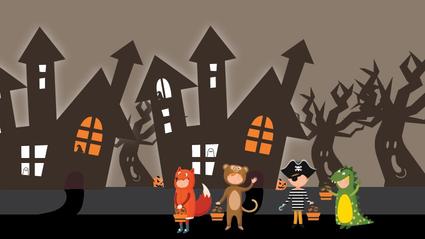
Stay Safe and Stay Spooky
This article is also available as a downloadable PDF file.
Bethany Folsom, MS CCLS, CPST
Pediatric Trauma Injury Prevention Health Educator
C.S. Mott Children’s Hospital – Ann Arbor, Michigan
School is back in session, the weather is getting cooler, and the Halloween merchandise has hit the stores. This means that hopefully trick-or-treating is just around the corner and it’s a good time for a refresher on ways to keep kids safe this Halloween season.
Looking Good While Being Safe
- In years past one of the biggest safety tips shared was to avoid full face masks and to consider using face paint instead. Costume masks that cover the face can limit vision and those that go over the head can affect hearing as well as vision. This year, wear a mask – a face mask that is! Be creative: find ways to incorporate a protective face mask into costumes, and continue to avoid the costume masks that can cause problems.
- Try on costumes ahead of time and make sure that they fit appropriately. Costumes that are too long can be a tripping hazard. Practice walking and allow for good range of motion. Take a look at the quantity of costume items. Kids should have at least one hand free of costume accessories.
- Make sure that kids are visible while trick-or-treating. It gets dark earlier in the evening, often during trick-or-treat times. Look for ways to add reflective strips/tape, glow in the dark items, or even lights into costumes. Trick-or-treaters can also carry flashlights to help see and be seen.
Walk This Way
- Halloween is one of the busiest nights of the year for pedestrians as trick-or-treating is fun for all ages. Practice safe walking habits such as staying out of the street and using the sidewalks. While it could be tempting to cross the street back and forth to get to more houses, drivers may not be able to spot people who are unexpectedly in the street. While on the sidewalk, keep an eye out for cars that are pulling in or out of driveways and alleys.
- Use the crosswalks at intersecting streets to get to the other side. Often intersections have stop signs where drivers should be stopping, but even if there is not, drivers should be watching for pedestrians. Even though vehicles should stop at crosswalks or for pedestrians, don’t assume that they will. Pause before crossing, look for moving vehicles to the left, to the right, and to the left again. Walk across the street while continuing to keep an eye out for cars, and make eye contact with drivers when possible.
- Pay attention while out and about. Put cell phones down and watch out for obstacles and potential dangers along the way.
Fun With Friends
- Kids under the age of 13 should trick or treat with a responsible adult who is actively supervising. As kids get older they will often want to go with friends. Communication between teenagers and caregivers is key: set up a plan including who teenagers are going with, where they will be going and what time they will be home.
- Stay in familiar neighborhoods and areas that are well-lit. Visit houses with the lights on, but stop at the porch: never enter a home.
Sweet Treats
- Inspect candy after arriving at home. Only keep and eat treats that are familiar to you and that are sealed in the original wrapper. Discard any suspicious looking candy, or treats that are not in original wrappers.
- Set up a guideline of when and how much candy children should eat.
Safe Driving During Prime Time
- If possible, avoid driving during trick-or-treating hours. If driving is necessary, proceed with extra caution: drive slowly and watch for children who may dart into or across the street mid-block. Before exiting/entering a driveway or moving through an intersection, check for pedestrians in all directions. As it gets darker, they may be more difficult to spot.
- When driving kids to different houses, streets, or neighborhoods, make sure that they are buckled up. Vehicles should come to a complete stop before kids unbuckle, open the door, and hop out.
- Teach teenagers who need to drive during trick-or-treating hours about the importance of driving slowly and safely. Remind them keep alert, avoid distractions, and pay attention to the road, checking for pedestrians as they navigate through neighborhoods.
Bethany Folsom, MS, CCLS, CPST is a Health Educator with C.S. Mott Children’s Hospital through their Pediatric Trauma Injury Prevention Program. She is especially interested in medication safety, bicycle safety, and pedestrian safety and instructs people of all ages in the importance of injury prevention concepts.
